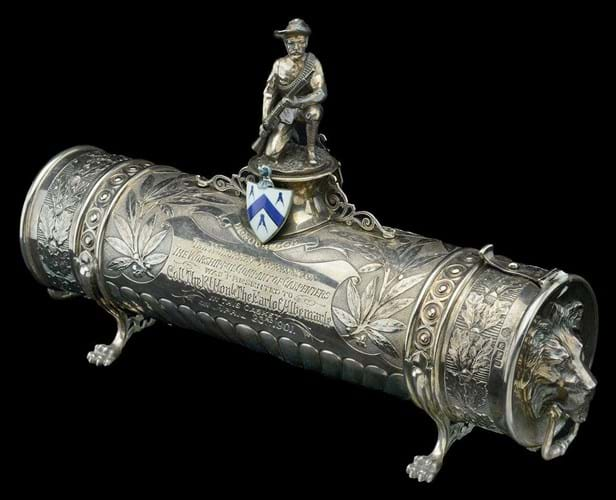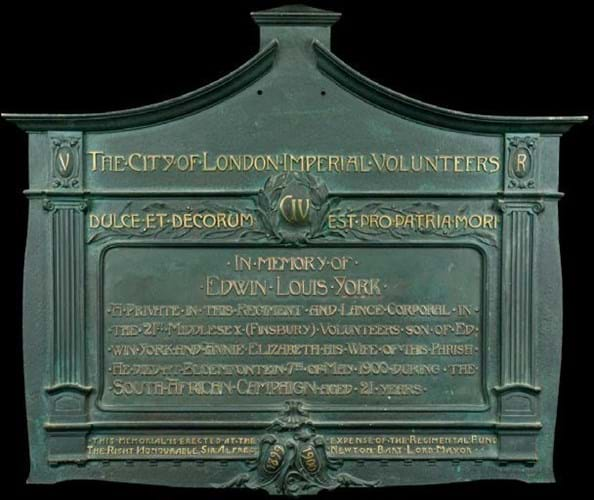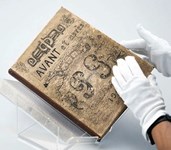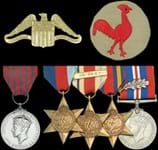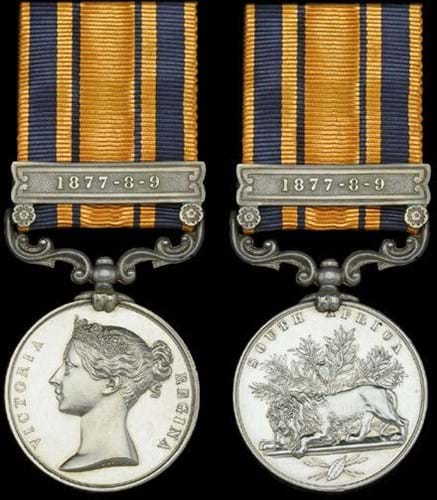
He amassed a collection which produced a 992-lot white-glove sale at specialist auction house Dix Noonan Webb (24% buyer’s premium).
Far exceeding the auctioneer Nimrod Dix’s estimate, the August 20 London sale hammered nearly £800,000, led by the naval version of a Napoleonic Imperial Eagle. It is the only one known in private hands and doubled the lower estimate going to a dealer at £40,000 (see front page ATG No 2456).
Apart from the Imphal-Kohima George Medal, the higher selling medals were mainly general issues with clasps which subtly say ‘I was there’ rather than ‘I’m a recognised hero’.
Zulu conflict
Isandhlwana, where assegai-wielding Zulus slaughtered Lord Chelmsford’s 1800-strong invasion force in 1879, is little known in the UK. Among the 1400 British dead was Captain George Wardell of the 1/24th Foot. His posthumous Zulu War medal with South Africa 1877-79 clasp was in extremely fine condition and took a double-estimate £36,000. As with most major purchases, it went to a UK collector.
Chelmsford’s humiliating defeat was played down back in the UK. The emphasis instead fell on a minor action six miles away that same evening and following day. At Rorke’s Drift, 3000-4000 Zulus attacked the 150-strong garrison.
Of the 11 VCs awarded to defenders, Sir Garnet Wolseley, who replaced Chelmsford, said: “It is monstrous making heroes of those who, shut up in buildings …could not bolt and fought like rats for their lives.”
However, reinforced by the 1964 film Zulu, the battle has legendary status. The last of the Rorke’s Drift VCs in private hands was bought by Lord Ashcroft for £80,000 at DNW in 1996. In the unlikely event of one coming to market today, Dix believes it would make at least £500,000.
General Zulu War medals from the action are pulled to new heights in the wake. Three years ago, one given to commanding officer John Chard’s batman made £110,000 at DNW and on August 20 an example awarded to another of the 138 survivors, Private Thomas Moffatt, sold within estimate at £28,000.
Peninsular prize
The Peninsular War (1807-14) has its own dedicated following.
A very fine Major General Service Medal 1793-1814 with eight clasps was awarded to Private Jack Hanley of the 40th Foot, who was wounded at the infamous siege of Badajoz but recovered to fight in every major Peninsular action. Offered with his Waterloo Medal with a guide of £2000-2600, the pair sold at £4200.
In 1814 Hanley was at the Nivelle where, with senior officers dead or injured, Captain Joseph Mark took over command of the 57th Foot. He then led them in the follow-up battle of Nive. His Field Officer’s Gold Medal for Nivelle and clasp for Nive, along with letters from the Duke of York, were in extremely fine condition. The buyer at £19,000 (estimate £14,000-18,000) was a descendant.
Afghan disaster
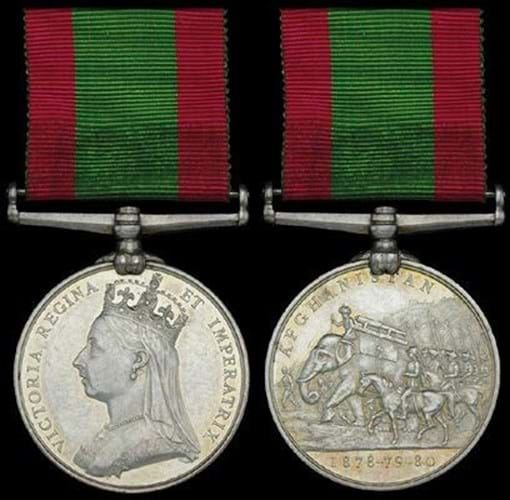
Afghanistan 1878-80 medal awarded to Lieutenant Edmund Osborne – £16,000 at Dix Noonan Webb.
Britain’s ongoing, bloody and largely futile involvement in Afghanistan began in the 19th century. After the disastrous retreat from Kabul in January 1842, about 900 British and Indian soldiers at the isolated garrison at Kelat-i-Ghilzie held off repeated attacks by a 6000 strong Afghan force until relieved in May.
A Defence of Kelat-i-Ghilzie medal awarded to Gunner Joseph Martin of the Bengal Artillery went over estimate at £6500.
Nearly 40 years later, during the Second Afghan War, the British- Indian army were defeated at Maiwand. Among the 969 dead was Lieutenant Edmund Osborne of the Royal Horse Artillery, who mounted a horse and charged the enemy with his sword to save a comrade’s life at the cost of his own.
His Afghanistan 1878-80 medal, in extremely fine condition, was estimated at £7000-9000 and sold at £16,000.
Few of the many 19th century British battles around the globe would pass today’s ‘woke’ scrutiny, certainly not the bloody victory at Maharajapore in 1843 against the Maratha empire which cemented British rule over most of northern and central India.
It was remembered at DNW in the form of the Maharajapor Star awarded to 2nd Lieutenant George Franklin Atkinson of the Bengal Engineers. The original ribbon was very distressed but the medal was catalogued as good, very fine and very rare and, at £7000, went for seven times the top estimate.
Rogue rewarded

Defence of Legations medal awarded to Bertram Simpson during the Boxer Rebellion – £11,000 at Dix Noonan Webb.
Among the 730 medals at DNW there was room for a rogue: one Bertram Simpson awarded the 1900 Defence of the Legations medal, alluding to the 55-day siege of international quarter of Peking during the Boxer Rebellion.
Simpson, a linguist working with the Chinese customs, was mentioned in dispatches for ‘exceptionally good service’ by British Minister Sir Claude MacDonald.
After the siege was relieved, Simpson was involved in organised looting on a scale only a Chinese speaker could manage. When a warrant was issued for his arrest, Simpson fled, travelling widely in the Far East while working as a political adviser to a sequence of Chinese governments.
In 1930, when in Tientsin organising propaganda for Northern Coalition rebels in the civil war, the Nanking Government requested his deportation to Britain. Instead Simpson was shot dead by three Chinese assassins in his house.
His Boxer Rebellion medal was estimated at £6000-8000 and sold at £11,000.
Voluntary service
Outside of Webb’s medals, one of the highest prices was taken for a ‘freedom’ casket presented by the Carpenters’ Company to Colonel the Earl of Albemarle in recognition of his services with the City of London Imperial Volunteers.
The earl was colonel of the 12th Middlesex (Civil Service) Rifles and commanded the infantry battalion of the Imperial Volunteers during the Boer War. Pitched at £3000-4000, the 17in (44cm) long silver and enamelled cylindrical casket sold at £11,000.
The various Middlesex volunteer regiments and the Imperial Volunteers were of particular interest to Webb – about 170 medals, badges and accoutrements relating to them were on offer.
The two came together in a cast bronze memorial plaque removed when a bombed-out Highbury church was rebuilt in 1950.
One of 72 such plaques commissioned for the fallen by the Lord Mayor of London, it commemorated Edwin Yorke, a private in the 21st Middlesex (Finsbury) Volunteers and lance corporal in the City of London Imperial Volunteers who died in 1900 at Bloemfontein aged 21.
Cast by Coalbrookdale, the 2ft 9in (85cm) wide plaque had some losses but was in otherwise good condition and against a £300-500 estimate sold at £4800.
Gorgeous gorget
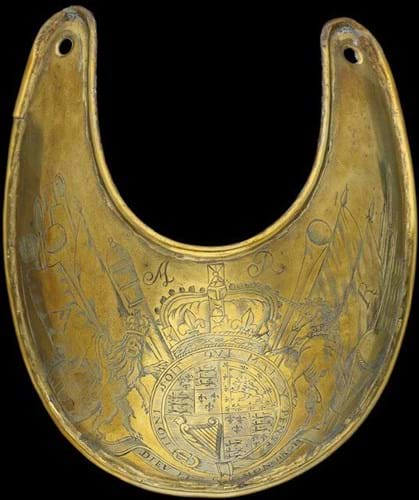
A c.1785-97 copper-gilt gorget worn by an officer of the 57th (West Middlesex) Regiment – £3400 at Dix Noonan Webb.
Increasingly sought by collectors, 21 late 18th and early 19th century gorgets were on offer led by a c.1785- 97 copper-gilt example worn by an officer of the 57th (West Middlesex) Regiment.
Partially rubbed and with some dents, it was otherwise in good condition and made an eight-times estimate £3400.



